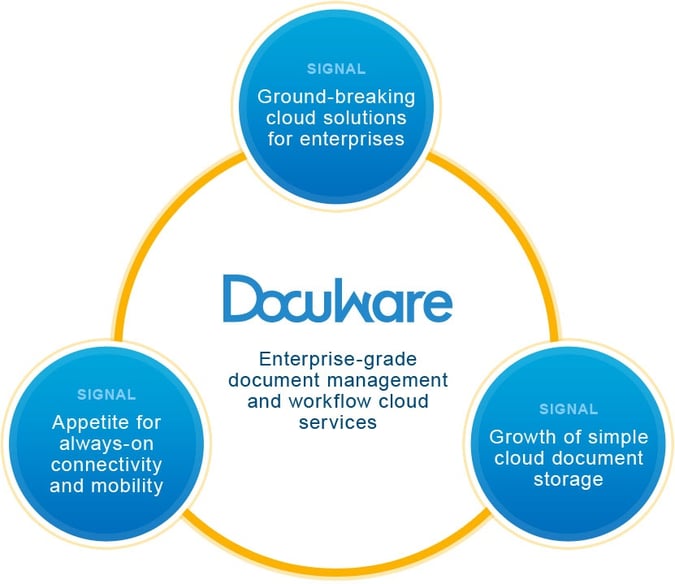Welcome to Part 1 of our new mini-series of blog posts, “Leading in the Cloud”. Over the course of five posts, we’ll track DocuWare’s journey from a traditional on-premises software company to a market-leading cloud services company, all while staying true to our customers, partners and product vision.
The first installment covers the signals we saw in the marketplace that initiated our move to the cloud – even though no one else was doing it.
We Were Doing Just Fine Without the Cloud
By today’s startup pace, DocuWare is not a young company. Founded nearly 30 years ago, we’ve been building and delivering document management and workflow technology for customers all over the world.
While many of our competitors build complex products reliant on expensive, lengthy and painful professional services, DocuWare designed technology for the masses under a simple idea: help the knowledge worker do their job, and avoid the IT headaches of complicated software.
Some Metrics of Our Growth
Our strategy was sound: we built a robust channel business (over 500 partners today) that delivered growth and profitability for literally decades. We went global (70 countries, 16 languages), we spanned industries (hundreds) and gained thousands of loyal users (over 175,000). In short: DocuWare was doing great selling enterprise, on-premises software.
Cloud Was Fringe
With years of growth and no signs of slowing, why did DocuWare move to the cloud? Competitors weren’t chasing it. Customers weren’t demanding it. Analysts were barely talking about it. In those early days, cloud was a fringe idea with high barriers of skepticism.
Early Signals of Something Big
Web applications have been around almost since the dawn of the Web. Online email, for instance, signaled a new way of thinking about a browser: instead of a means to consume static information, it became a means to create and move dynamic information. This concept shifted the entire foundation of the web from publishing-centric XHTML to application-centric HTML5.
Redefining Applications for the Consumer
Within years, consumers were provided online tools that changed our definition of “application.” Google revolutionized email with Gmail, mapping software with Google Maps, office applications with Google Docs. BaseCamp provided teams with agile project management. Social networks like Facebook were conceived, born and grown within a browser. DropBox handled basic file storage. Suddenly, productivity could blossom without ever installing a local piece of software. And consumers loved it.
The consumer drive to cloud was made complete with the launch of the iPhone. Overnight, the world moved to apps and always-on connectivity. Cloud was the backbone.
Redefining Applications for the Enterprise
On the enterprise side, Salesforce ushered in a complete revolution in how organizations acquired, consumed, scaled and paid for their mission-critical technology. “Subscription services” replaced “licensed software.” The entire buying cycle moved from IT to business owner.
Still, most ECM players ignored the trends. The industry heavy-weights stubbornly focused on traditional, on-premises software despite every market signal pointing to a very different-looking future.

The market signals that drove the decision to build DocuWare Cloud.
For DocuWare, the signals were clear: user-centric, mobile-enabled connectivity; large-scale sales teams embracing cloud-driven CRM; individuals and business units embracing cloud file storage.
We assumed, correctly as it turns out, that businesses would want to shed the weight of their outdated ECM technology and employ document management, process automation and intelligent document workflow delivered via cloud.
The Benefits of Cloud Document Management
Specifically, our decision was driven by the following customer benefits of cloud:
- No local installation, including plugins
- No hardware and software maintenance, including upgrades and security patches
- Always using the latest software
- Only pay for services actually used
- Subscription model removes price barrier to entry
- World-wide, high-availability access
- More efficient use of resources à green technology
Our Milestones Building a Modern Cloud Service
2002 – Our R&D team redesigned DocuWare with a highly scalable, multi-layered architecture.
2008 – DocuWare launched a robust web client where users could access central document pools from any location. This was a very popular extension of the core DocuWare system for individuals who did not want to install software and plugins on local workstations.
2009 – DocuWare offered its first software as a service (SaaS) through the private cloud.
2010 – Decision to build a true cloud solution.
2012 – DocuWare delivered its first public cloud SaaS offering called DocuWare Online. This landmark release enabled rapid registration and delivered 80 percent of the features from the on-premises solution.
2014 – DocuWare Online was renamed DocuWare Cloud and moved onto the Microsoft Azure platform.
Today: a Complete Cloud Office Automation Solution
Today, there is now 100% feature and user experience parity between DocuWare Cloud and the DocuWare on-premises solution. None of our competitors have delivered this “complete cloud” vision. But we believe in a zero-compromise product that provides customers choice in how and when they want to bring DocuWare into their cloud strategy.
The response has been enthusiastic. In future blog posts, we’ll cover customer and revenue growth with our cloud services, and explore the many technical challenges we solved along the way.
Visit www.blog.docuware.com for the rest of the series.


Comments (0)